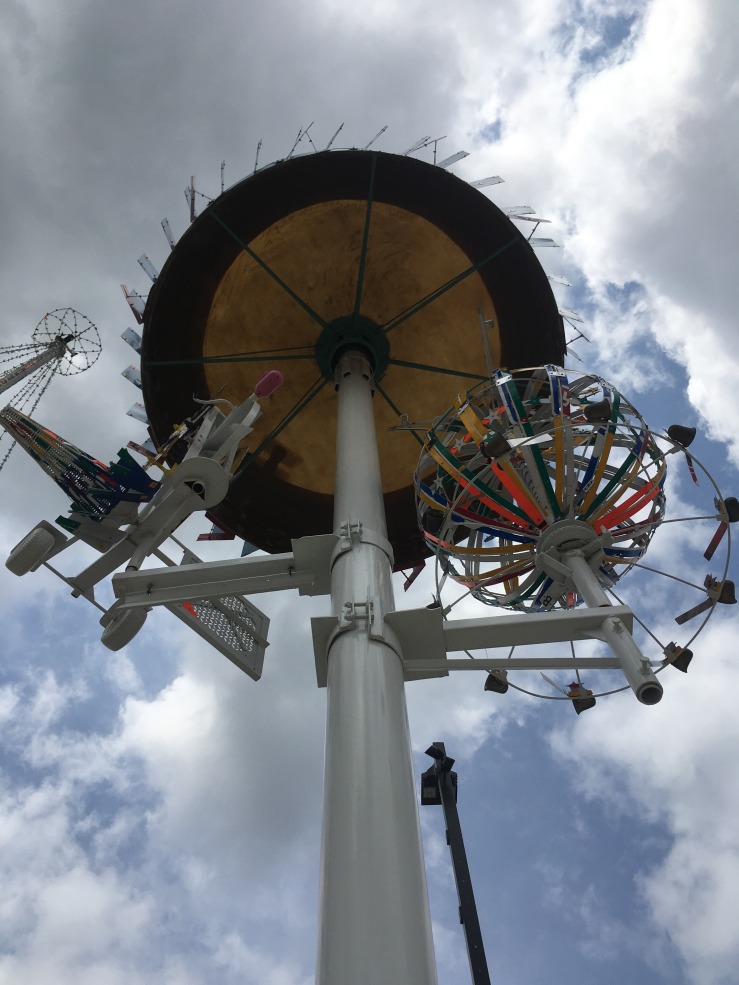Hi.
Coffee: India Extra Bold Roast, Cafe Crema
I went to see the Wirligigs in Wilson. For those that don’t know, Vollis Simpson – a Wilson County native – spent his retirement creating massive metal whippets and doodads, colorful, wind-catching, made to sparkle and spin. He was a farmer by birth, soldier by necessity, and mechanic by trade. Before his death, people were buying his whirligigs and sticking them in art museums.
The park was flat ground with an amphitheater, not all that big. The Whirligigs sat around like old dogs surviving summer. Though it was cloudy, there wasn’t much wind and not much was spinning. I walked one full circle of the park, passing three old couples and two women holding hands. It was ghost-quiet. Around us, old brick buildings squatted in differing states of disrepair.
I left the park. I drove through the city, I wanted to see the place that inspired Simpson’s work. I saw a lot of dilapidated houses and chipped paint. There was a big bright BB&T building, but even it looked worn. A wooden train station was packed with people who didn’t have the time to think about appearances, slumped on old benches, struggling to find shade in the holey awning. Across the tracks, police courted a black neighborhood.
Wilson is the unspoken truth of America. She’s put the prom dress down, wiped the make-up away, closed the door on media suitors. She’s not the pastoral daisy of the Right or the verdant commune of the Left. She’s not a hard-working town, a bustling city, the techy suburbs. She’s a place that had it’s prime fifty years ago, one perfect dance under the starlight. Now it’s morning.
There was art everywhere in the City. Black murals on black churches; a series of photographs that caught glints of Civil Rights. According to the census, Wilson is an almost even split white and black. Driving around, all the white faces popped up around the suburbs, the city-center was all black. There were newer buildings in the suburbs, better roads, but it’s one claim to culture was the catch-all of a bloated Wal-Mart. In that way, Wilson is also America: white men and women cling to money whispering into it a faded, fifty-year dream; meanwhile, minorities wrestle with the deck stacked against them after all this time. We voted well in the 60’s, but no-one’s ever learned how to talk to each other. A fractured past, two trauma’s separated by train-tracks, forgotten in a world that sold it’s shipping overseas.
Simpson’s sculptures didn’t do much for me when I was standing under them, but they made more sense after my drive through the city. They were brilliant, vibrant, but sterile. Some moved limply, others simply wanted to move. As a young man, Simpson fought in WWII; he came home to watch the world change. In all substantial ways, America looks better – even in 2018 – than she had in the prime-time years of the 50’s. But the reckoning took a toll. Some of us – those lucky by birth, money, skin, whatever – live on the cutting edge future. The rest of America is Wilson – a beautiful post-depression, grappling with the grief of knowing what precious looks like but never knowing how to open her hands wide enough to hold it.
Tall wild metal, spinning and spinning.
Currently Reading: LaRose, Louise Erdrich
Support Relief for Family Suffering at the Border – RAICES DONATION CAMPAIGN
“I guess it’ll just rust and fall down when I’m gone.” – Vollis Simpson, interview in the New York Times from 2010
